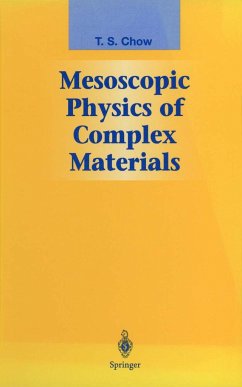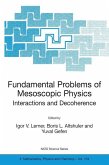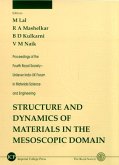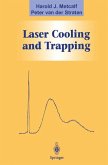T. S. Chow
Mesoscopic Physics of Complex Materials
T. S. Chow
Mesoscopic Physics of Complex Materials
- Gebundenes Buch
- Merkliste
- Auf die Merkliste
- Bewerten Bewerten
- Teilen
- Produkt teilen
- Produkterinnerung
- Produkterinnerung
A cross-disciplinary study of the physical properties of complex fluids, solids, and interfaces as a function of their mesoscopic structures, with empasis on nonequilibrium phenomena. The book introduces readers to the methods of non-equilibrium statistical mechanics as applied to complex materials, but always connects theories with experiments. It shows the underlying connections between topics as diverse as critical phenomena in colloidal dynamics, glassy state relaxation and deformation, reinforced polymer composites, molecular level mixing in nanocomposites, and rough surfaces and…mehr
Andere Kunden interessierten sich auch für
![Fundamental Problems of Mesoscopic Physics Fundamental Problems of Mesoscopic Physics]() Igor V. Lerner / Boris L. Altshuler / Yuval Gefen (Hgg.)Fundamental Problems of Mesoscopic Physics242,99 €
Igor V. Lerner / Boris L. Altshuler / Yuval Gefen (Hgg.)Fundamental Problems of Mesoscopic Physics242,99 €![Structure and Dynamics of Materials in the Mesoscopic Domain - Proceedings of the Fourth Royal Society-Unilever Indo-UK Forum in Materials Science and Engineering Structure and Dynamics of Materials in the Mesoscopic Domain - Proceedings of the Fourth Royal Society-Unilever Indo-UK Forum in Materials Science and Engineering]() Structure and Dynamics of Materials in the Mesoscopic Domain - Proceedings of the Fourth Royal Society-Unilever Indo-UK Forum in Materials Science and Engineering151,99 €
Structure and Dynamics of Materials in the Mesoscopic Domain - Proceedings of the Fourth Royal Society-Unilever Indo-UK Forum in Materials Science and Engineering151,99 €![Interfaces for the 21st Century: New Research Directions in Fluid Mechanics and Materials Science Interfaces for the 21st Century: New Research Directions in Fluid Mechanics and Materials Science]() Interfaces for the 21st Century: New Research Directions in Fluid Mechanics and Materials Science126,99 €
Interfaces for the 21st Century: New Research Directions in Fluid Mechanics and Materials Science126,99 €![Computer Simulations in Condensed Matter: From Materials to Chemical Biology. Volume 2 Computer Simulations in Condensed Matter: From Materials to Chemical Biology. Volume 2]() Mauro Ferrario / Giovanni Ciccotti / Kurt Binder (eds.)Computer Simulations in Condensed Matter: From Materials to Chemical Biology. Volume 242,99 €
Mauro Ferrario / Giovanni Ciccotti / Kurt Binder (eds.)Computer Simulations in Condensed Matter: From Materials to Chemical Biology. Volume 242,99 €![Soft Matter Physics Soft Matter Physics]() Maurice KlemanSoft Matter Physics361,99 €
Maurice KlemanSoft Matter Physics361,99 €![Computer Simulations in Condensed Matter: From Materials to Chemical Biology. Volume 2 Computer Simulations in Condensed Matter: From Materials to Chemical Biology. Volume 2]() Computer Simulations in Condensed Matter: From Materials to Chemical Biology. Volume 239,99 €
Computer Simulations in Condensed Matter: From Materials to Chemical Biology. Volume 239,99 €![Laser Cooling and Trapping Laser Cooling and Trapping]() Harold J. MetcalfLaser Cooling and Trapping55,99 €
Harold J. MetcalfLaser Cooling and Trapping55,99 €-
-
-
A cross-disciplinary study of the physical properties of complex fluids, solids, and interfaces as a function of their mesoscopic structures, with empasis on nonequilibrium phenomena. The book introduces readers to the methods of non-equilibrium statistical mechanics as applied to complex materials, but always connects theories with experiments. It shows the underlying connections between topics as diverse as critical phenomena in colloidal dynamics, glassy state relaxation and deformation, reinforced polymer composites, molecular level mixing in nanocomposites, and rough surfaces and interfaces. At the same time, each chapter is designed to be independent from the others so that the book can serve as a reference work as well as a text. It is not designed to review all the recent work in mesoscopic physics, which spans many disciplines, but rather attempts to establish a general framework for understanding and developing new materials that can not be designed by the trial and error methods. A familiarity with the basics of statistical mechanics and condensed matter physics is assumed.
Hinweis: Dieser Artikel kann nur an eine deutsche Lieferadresse ausgeliefert werden.
Hinweis: Dieser Artikel kann nur an eine deutsche Lieferadresse ausgeliefert werden.
Produktdetails
- Produktdetails
- Graduate Texts in Contemporary Physics
- Verlag: Springer, Berlin
- 2000.
- Seitenzahl: 196
- Erscheinungstermin: 25. August 2000
- Englisch
- Abmessung: 242mm x 160mm x 14mm
- Gewicht: 408g
- ISBN-13: 9780387950327
- ISBN-10: 038795032X
- Artikelnr.: 09225331
- Herstellerkennzeichnung
- Libri GmbH
- Europaallee 1
- 36244 Bad Hersfeld
- gpsr@libri.de
- Graduate Texts in Contemporary Physics
- Verlag: Springer, Berlin
- 2000.
- Seitenzahl: 196
- Erscheinungstermin: 25. August 2000
- Englisch
- Abmessung: 242mm x 160mm x 14mm
- Gewicht: 408g
- ISBN-13: 9780387950327
- ISBN-10: 038795032X
- Artikelnr.: 09225331
- Herstellerkennzeichnung
- Libri GmbH
- Europaallee 1
- 36244 Bad Hersfeld
- gpsr@libri.de
1 Overview.- 1.1 Statistical Dynamics.- 1.2 Fluid Dispersions.- 1.3 Relaxation in Solids.- 1.4 Nanocomposites.- 1.5 Fractal Surfaces.- Appendix 1A Viscoelasticity.- 2 Brownian Motion.- 2.1 Markovian Process.- 2.2 Langevin Equation.- 2.3 Random Force Correlation.- 2.4 Fokker Planck Equation.- 2.5 Memory Effect.- Appendix 2A The Navier Stokes Equation.- Appendix 2B The Liouville Theorem.- 3 Dynamic Response.- 3.1 Linear Response Theory.- 3.2 Correlation Functions.- 3.3 Generalized Susceptibility.- 3.4 Fluctuation Dissipation Theorem.- 3.5 Non-Markovian and Nonlocal Relations.- 3.6 Relaxation Time.- 3.7 The Master Equation.- 4 Colloidal Dynamics.- 4.1 Stokesian Dynamics.- 4.2 Anistropic Viscosities.- 4.3 Lattice Model.- 4.4 Concentrated Dispersions.- 4.5 Percolation Transition.- 4.6 Memory Function.- 4.7 Dynamic Viscosities.- 4.8 Mesoscopic Dynamics.- 4.9 Shear Thinning.- 4.10 Colloid Growth Model.- 4.11 Polymer Gels.- Appendix 4A Fractals.- 5 Glassy-State Relaxation.- 5.1 Equilibrium State.- 5.2 Free-Volume Distribution.- 5.3 Fractal Dynamic Theory of Glasses.- 5.4 Relaxation Function and Time.- 5.5 Relaxation Spectum.- 5.6 Volume Relaxation and Recovery.- 5.7 PVT Equation of State.- 6 Glassy Polymers.- 6.1 Glass Transition.- 6.2 Physical Aging.- 6.3 Dynamic Viscoelastic Properties.- 6.4 Yield Behavior.- 6.5 Stress-Induced Glass Transition.- 6.6 Activation Volume Tensor.- 6.7 Nonlinear Stress Strain Relationships.- 7 Polymer Composites.- 7.1 Anisotropic Elasticity.- 7.2 Elastic Constants.- 7.3 Thermal Expansion.- 7.4 Stress Concentration.- 7.5 Nonequilibrium Mechanical Properties.- 7.6 Compatible Polymer Blends.- 7.7 Molecular Composites.- 7.8 Nanocomposites.- Appendix 7A Eshelby s Tensor.- 8 Rough Surfaces and Interfaces.- 8.1 Fractal Surfaces.- 8.2 Noise and Fluctuations.- 8.3 Fluctuations of Contact Line.- 8.4 Wetting and Adhesion.- 8.5 Critical Surface Tension.- 8 6 Dynamics of Wetting.- 8.7 Adhesional Friction.- 8.8 Deformational Friction.- 8.9 Diffuse
1 Overview.- 1.1 Statistical Dynamics.- 1.2 Fluid Dispersions.- 1.3 Relaxation in Solids.- 1.4 Nanocomposites.- 1.5 Fractal Surfaces.- Appendix 1A Viscoelasticity.- 2 Brownian Motion.- 2.1 Markovian Process.- 2.2 Langevin Equation.- 2.3 Random Force Correlation.- 2.4 Fokker-Planck Equation.- 2.5 Memory Effect.- Appendix 2A The Navier-Stokes Equation.- Appendix 2B The Liouville Theorem.- 3 Dynamic Response.- 3.1 Linear Response Theory.- 3.2 Correlation Functions.- 3.3 Generalized Susceptibility.- 3.4 Fluctuation-Dissipation Theorem.- 3.5 Non-Markovian and Nonlocal Relations.- 3.6 Relaxation Time.- 3.7 The Master Equation.- 4 Colloidal Dynamics.- 4.1 Stokesian Dynamics.- 4.2 Anistropic Viscosities.- 4.3 Lattice Model.- 4.4 Concentrated Dispersions.- 4.5 Percolation Transition.- 4.6 Memory Function.- 4.7 Dynamic Viscosities.- 4.8 Mesoscopic Dynamics.- 4.9 Shear Thinning.- 4.10 Colloid Growth Model.- 4.11 Polymer Gels.- Appendix 4A Fractals.- 5 Glassy-State Relaxation.- 5.1 Equilibrium State.- 5.2 Free-Volume Distribution.- 5.3 Fractal Dynamic Theory of Glasses.- 5.4 Relaxation Function and Time.- 5.5 Relaxation Spectum.- 5.6 Volume Relaxation and Recovery.- 5.7 PVT Equation of State.- 6 Glassy Polymers.- 6.1 Glass Transition.- 6.2 Physical Aging.- 6.3 Dynamic Viscoelastic Properties.- 6.4 Yield Behavior.- 6.5 Stress-Induced Glass Transition.- 6.6 Activation Volume Tensor.- 6.7 Nonlinear Stress-Strain Relationships.- 7 Polymer Composites.- 7.1 Anisotropic Elasticity.- 7.2 Elastic Constants.- 7.3 Thermal Expansion.- 7.4 Stress Concentration.- 7.5 Nonequilibrium Mechanical Properties.- 7.6 Compatible Polymer Blends.- 7.7 Molecular Composites.- 7.8 Nanocomposites.- Appendix 7A Eshelby's Tensor.- 8 Rough Surfaces and Interfaces.- 8.1 Fractal Surfaces.- 8.2 Noise andFluctuations.- 8.3 Fluctuations of Contact Line.- 8.4 Wetting and Adhesion.- 8.5 Critical Surface Tension.- 8 6 Dynamics of Wetting.- 8.7 Adhesional Friction.- 8.8 Deformational Friction.- 8.9 Diffuse Scattering.- 8.10 Surface Growth.- Appendix 8A Surface Forces.
1 Overview.- 1.1 Statistical Dynamics.- 1.2 Fluid Dispersions.- 1.3 Relaxation in Solids.- 1.4 Nanocomposites.- 1.5 Fractal Surfaces.- Appendix 1A Viscoelasticity.- 2 Brownian Motion.- 2.1 Markovian Process.- 2.2 Langevin Equation.- 2.3 Random Force Correlation.- 2.4 Fokker Planck Equation.- 2.5 Memory Effect.- Appendix 2A The Navier Stokes Equation.- Appendix 2B The Liouville Theorem.- 3 Dynamic Response.- 3.1 Linear Response Theory.- 3.2 Correlation Functions.- 3.3 Generalized Susceptibility.- 3.4 Fluctuation Dissipation Theorem.- 3.5 Non-Markovian and Nonlocal Relations.- 3.6 Relaxation Time.- 3.7 The Master Equation.- 4 Colloidal Dynamics.- 4.1 Stokesian Dynamics.- 4.2 Anistropic Viscosities.- 4.3 Lattice Model.- 4.4 Concentrated Dispersions.- 4.5 Percolation Transition.- 4.6 Memory Function.- 4.7 Dynamic Viscosities.- 4.8 Mesoscopic Dynamics.- 4.9 Shear Thinning.- 4.10 Colloid Growth Model.- 4.11 Polymer Gels.- Appendix 4A Fractals.- 5 Glassy-State Relaxation.- 5.1 Equilibrium State.- 5.2 Free-Volume Distribution.- 5.3 Fractal Dynamic Theory of Glasses.- 5.4 Relaxation Function and Time.- 5.5 Relaxation Spectum.- 5.6 Volume Relaxation and Recovery.- 5.7 PVT Equation of State.- 6 Glassy Polymers.- 6.1 Glass Transition.- 6.2 Physical Aging.- 6.3 Dynamic Viscoelastic Properties.- 6.4 Yield Behavior.- 6.5 Stress-Induced Glass Transition.- 6.6 Activation Volume Tensor.- 6.7 Nonlinear Stress Strain Relationships.- 7 Polymer Composites.- 7.1 Anisotropic Elasticity.- 7.2 Elastic Constants.- 7.3 Thermal Expansion.- 7.4 Stress Concentration.- 7.5 Nonequilibrium Mechanical Properties.- 7.6 Compatible Polymer Blends.- 7.7 Molecular Composites.- 7.8 Nanocomposites.- Appendix 7A Eshelby s Tensor.- 8 Rough Surfaces and Interfaces.- 8.1 Fractal Surfaces.- 8.2 Noise and Fluctuations.- 8.3 Fluctuations of Contact Line.- 8.4 Wetting and Adhesion.- 8.5 Critical Surface Tension.- 8 6 Dynamics of Wetting.- 8.7 Adhesional Friction.- 8.8 Deformational Friction.- 8.9 Diffuse
1 Overview.- 1.1 Statistical Dynamics.- 1.2 Fluid Dispersions.- 1.3 Relaxation in Solids.- 1.4 Nanocomposites.- 1.5 Fractal Surfaces.- Appendix 1A Viscoelasticity.- 2 Brownian Motion.- 2.1 Markovian Process.- 2.2 Langevin Equation.- 2.3 Random Force Correlation.- 2.4 Fokker-Planck Equation.- 2.5 Memory Effect.- Appendix 2A The Navier-Stokes Equation.- Appendix 2B The Liouville Theorem.- 3 Dynamic Response.- 3.1 Linear Response Theory.- 3.2 Correlation Functions.- 3.3 Generalized Susceptibility.- 3.4 Fluctuation-Dissipation Theorem.- 3.5 Non-Markovian and Nonlocal Relations.- 3.6 Relaxation Time.- 3.7 The Master Equation.- 4 Colloidal Dynamics.- 4.1 Stokesian Dynamics.- 4.2 Anistropic Viscosities.- 4.3 Lattice Model.- 4.4 Concentrated Dispersions.- 4.5 Percolation Transition.- 4.6 Memory Function.- 4.7 Dynamic Viscosities.- 4.8 Mesoscopic Dynamics.- 4.9 Shear Thinning.- 4.10 Colloid Growth Model.- 4.11 Polymer Gels.- Appendix 4A Fractals.- 5 Glassy-State Relaxation.- 5.1 Equilibrium State.- 5.2 Free-Volume Distribution.- 5.3 Fractal Dynamic Theory of Glasses.- 5.4 Relaxation Function and Time.- 5.5 Relaxation Spectum.- 5.6 Volume Relaxation and Recovery.- 5.7 PVT Equation of State.- 6 Glassy Polymers.- 6.1 Glass Transition.- 6.2 Physical Aging.- 6.3 Dynamic Viscoelastic Properties.- 6.4 Yield Behavior.- 6.5 Stress-Induced Glass Transition.- 6.6 Activation Volume Tensor.- 6.7 Nonlinear Stress-Strain Relationships.- 7 Polymer Composites.- 7.1 Anisotropic Elasticity.- 7.2 Elastic Constants.- 7.3 Thermal Expansion.- 7.4 Stress Concentration.- 7.5 Nonequilibrium Mechanical Properties.- 7.6 Compatible Polymer Blends.- 7.7 Molecular Composites.- 7.8 Nanocomposites.- Appendix 7A Eshelby's Tensor.- 8 Rough Surfaces and Interfaces.- 8.1 Fractal Surfaces.- 8.2 Noise andFluctuations.- 8.3 Fluctuations of Contact Line.- 8.4 Wetting and Adhesion.- 8.5 Critical Surface Tension.- 8 6 Dynamics of Wetting.- 8.7 Adhesional Friction.- 8.8 Deformational Friction.- 8.9 Diffuse Scattering.- 8.10 Surface Growth.- Appendix 8A Surface Forces.








